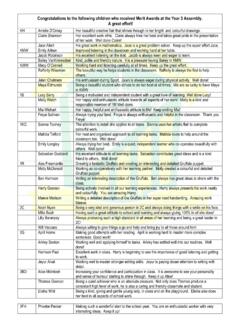Transcription of Niagara 4 Hardening Guide - Tridium
1 Niagara 4 Hardening Guide 10/10/2019 Tridium CONFIDENTIAL Page 1 of 42 Niagara 4 Hardening TABLE OF CONTENTS Passwords .. 4 Use the Password Strength Feature .. 4 Enable the Account Lockout Feature .. 6 Expire Passwords .. 7 Use the Password History .. 9 Use the Password Reset Feature .. 10 Leave the Remember These Credentials Box Unchecked .. 11 System Passphrase .. 13 Change the Default System Passphrase .. 13 Use TLS To Set the System Passphrase .. 14 Choose a Strong System Passphrase .. 14 Protect the System Passphrase .. 15 Ensure Platform Owner Knows the System Passphrase .. 15 Platform Account Management .. 15 Use a Different Account for Each Platform User .. 16 Use Unique Account Names for Each Project .. 18 Ensure Platform Owner Knows the Platform Credentials .. 18 Station Account Management .. 18 Use a Different Account for Each Station User .. 19 Use Unique Service Type Accounts for Each Project.
2 20 Disable Known Accounts When Possible .. 21 Set Up Temporary Accounts to Expire Automatically .. 21 Change System Type Account Credentials .. 22 Disallow Concurrent Sessions When Appropriate .. 22 Niagara 4 Hardening Guide 10/10/2019 Tridium CONFIDENTIAL Page 2 of 42 Role & Permission Management .. 23 Configure Roles with Minimum Required Permissions .. 23 Assign Minimum Required Roles to Users .. 24 Use the Minimum Possible Number of Super Users .. 24 Require Super User Permissions for Program Objects .. 24 Use the Minimum Required Permissions for External Accounts .. 24 Authentication .. 25 Use an Authentication Scheme Appropriate for the Account Type .. 25 Remove Unnecessary Authentication Schemes .. 27 TLS & Certificate Management .. 27 Enable Platform TLS 28 Enable Fox TLS Only .. 30 Enable Web TLS Only .. 31 Enable TLS on Other Services .. 33 Set Up Certificates .. 33 Module 33 Verify Module Permissions.
3 33 Additional Recommendations .. 34 Require Signed Program Objects and Robots .. 35 Disable SSH and SFTP .. 35 Disable Unnecessary Services .. 36 Configure Necessary Services Securely .. 37 Update Niagara 4 to the Latest Release .. 37 Address needs for dual approval .. 37 Provide proper management of audit logs .. 37 Provide mechanism for generating an alarm for audit processing failure .. 37 Allow only authorized management of Niagara Installation .. 37 Niagara 4 Hardening Guide 10/10/2019 Tridium CONFIDENTIAL Page 3 of 42 External Factors .. 37 Install Devices in a Secure Location .. 38 Make Sure that Stations Are Behind a VPN .. 38 Appendix A: Creating Strong Passwords That Are Actually Strong .. 39 Appendix B: Blacklist sensitive Files and Folders .. 40 Appendix C: Hardening Checklist .. 41 Niagara 4 Hardening Guide 10/10/2019 Tridium CONFIDENTIAL Page 4 of 42 INTRODUCTION This document describes how to implement security best practices in a Niagara 4 system.
4 While it is impossible to make any system completely impenetrable, there are many ways to build up a system that is more resilient to attacks. In particular, this document describes how you can help make a Niagara 4 system more secure by carefully configuring and using: Passwords System Passphrase Platform Account Management Station Account Management Role and Permission Management Authentication TLS and Certificate Management Module Installation Additional Settings External Factors Please note that while all of these steps should be taken to protect your Niagara 4 system, they do not constitute a magic formula. Many factors affect security and vulnerabilities in one area can affect security in another; it doesn t mean much to configure a system expertly if your jace is left physically unsecured where anyone can access it. PASSWORDS The Niagara 4 system typically uses passwords to authenticate users to a station or platform.
5 It is particularly important to handle passwords correctly. If an attacker acquires a user s password, they can gain access to the system and have the same permissions as that user. In the worst case, an attacker might gain access to a Super User account or platform account and the entire system could be compromised. Here are some of the steps that you can take to help secure the passwords in a Niagara 4 system: Use the Password Strength Feature Enable the Account Lockout Feature Expire Passwords Use the Password History Use the Password Reset Feature Leave the Remember These Credentials Box Unchecked USE THE PASSWORD STRENGTH FEATURE Many of the configurable authentication schemes in Niagara 4 support the notion of authenticating users with a password, but not all passwords are equally effective. Ensuring that users are choosing good, strong passwords is essential to securing a Niagara 4 system that uses password-based authentication schemes.
6 Niagara 4 Hardening Guide 10/10/2019 Tridium CONFIDENTIAL Page 5 of 42 In Niagara 4, password strength is enforced by the Password Strength property on the authentication scheme Global Password Configuration property and the required password strength can be customized to meet the needs of each particular system. By default, passwords are required to be at least 10 characters in length, and contain at least 1 digit, 1 uppercase and 1 lowercase character. At the time of the writing of this document, this is the recommended industry standard for most applications. However, systems with higher security requirements can configure the Password Strength property to require a password strength that meets their needs. Note that while password strength can be increased, it shouldn t be reduced. To change the required password strength, follow the steps described below. 1. Go to the station s AuthenticationService property sheet (Station > Config > Services > AuthenticationService).
7 2. Expand the Authentication Schemes folder and then expand the authentication scheme that you want to change. 3. Go to the Global Password Configuration property, expand the Password Strength property, and edit the fields as appropriate. 4. Save the changes. Note: This does not force a user whose password no longer meets the password strength requirement to change their passwords. If that user changes their password after the password strength requirements are modified, their new password will have to meet the new requirements. STRONGER PASSWORDS Even with good password strength requirements, there are some passwords that are stronger than others. It is important to educate users on password strength. Password strength requirements are not sufficient to ensure that actually strong passwords are used. For example, Password10 satisfies all the requirements, but is actually a Niagara 4 Hardening Guide 10/10/2019 Tridium CONFIDENTIAL Page 6 of 42 weak, easily hackable password.
8 When creating a password follow the guidelines in Appendix A: Creating Strong Passwords That Are Actually Strong to help you generate stronger passwords. ENABLE THE ACCOUNT LOCKOUT FEATURE The user lockout feature allows the UserService to lock out a user after a specified number of failed login attempts. That user is not able to log back in to the station until the lockout is removed. This helps protect the Niagara 4 system against attackers trying to guess or brute force users passwords. Account Lock Out is enabled by default, but if it is not currently enabled, you can enable it as described below: 1. Go to the station s UserService property sheet. 2. Set the Lock Out Enabled property to true. 3. Adjust the other lockout properties as necessary. Lock Out Period. This determines how long the user is locked out for. Even short periods (for example, 10 seconds) can be quite effective at blocking brute force attacks without inconveniencing users.
9 However, more sensitive systems may warrant a longer lockout period. Max Bad Logins Before Lock Out. This determines how many login failures are required before locking out the user. Lock Out Window. The user is only locked out if the specified number of login failures occurs within the time set in the Lock Out Window. This helps separate suspicious activity (for example, 10 login failures in a few seconds) from normal usage (for example, 10 login failures over a year). Niagara 4 Hardening Guide 10/10/2019 Tridium CONFIDENTIAL Page 7 of 42 4. Save the changes. EXPIRE PASSWORDS In Niagara 4, user passwords can be set to expire after a specified amount of time, or on a set date. This ensures that old passwords are not kept around indefinitely. If an attacker acquires a password, it is only useful to them until the password is changed. Expiration settings are configured on authentication schemes Global Password Configuration property sheets as well as on individual user properties.
10 PASSWORD EXPIRATION: PASSWORD CONFIGURATION PROPERTY SHEET Configure general password expiration settings in the UserService property sheet, as described below: 1. Go to the station s AuthenticationService property sheet. 2. Go to the Authentication Schemes folder, and find the authentication scheme for which you want to modify the password expiration. 3. Expand the Global Password Configuration property, and configure the expiration settings as necessary. Expiration Interval. This property setting determines how long a password is used before it needs to be changed. The default is 365 days. You should change this to a lower value; ninety days is standard for many situations. NOTE: You must also set individual user password expiration dates (See Password Expiration: Edit Users Dialog Box). Warning Period. Users are notified when their password is about to expire. The Warning Period specifies how far in advance the user is notified.




